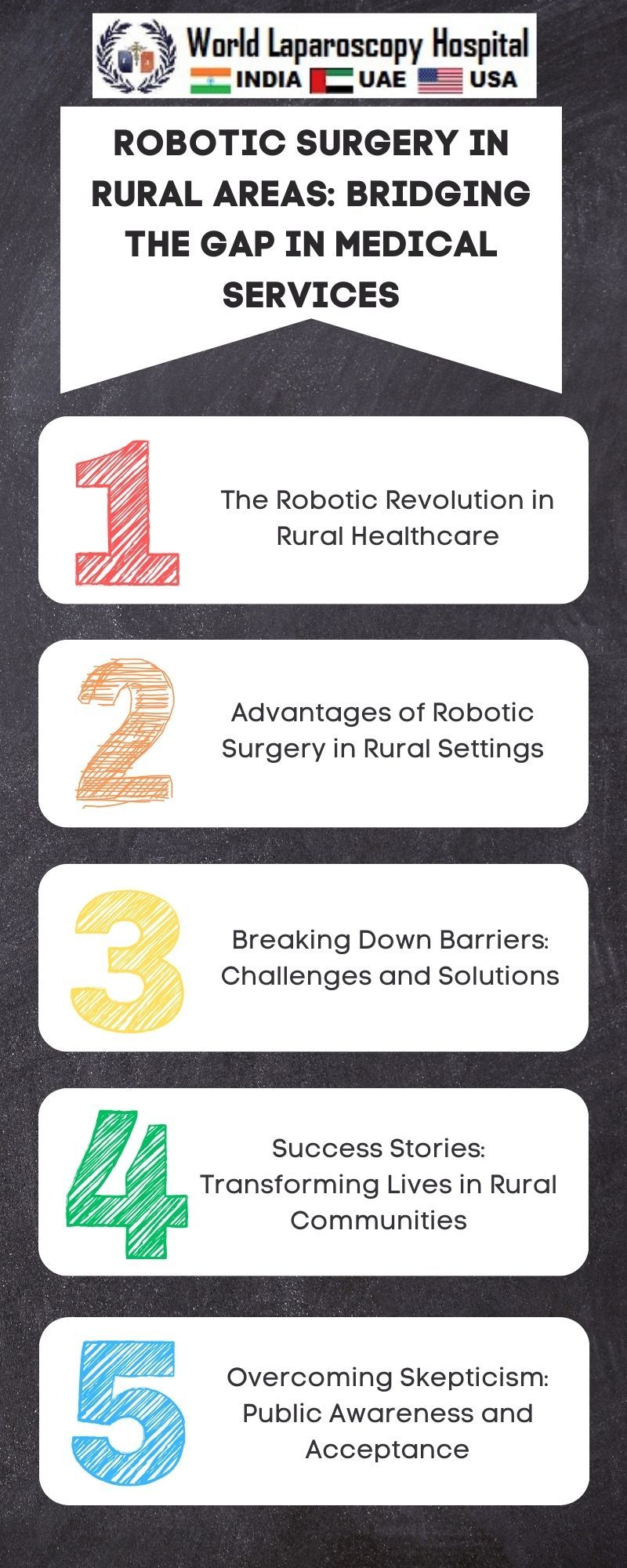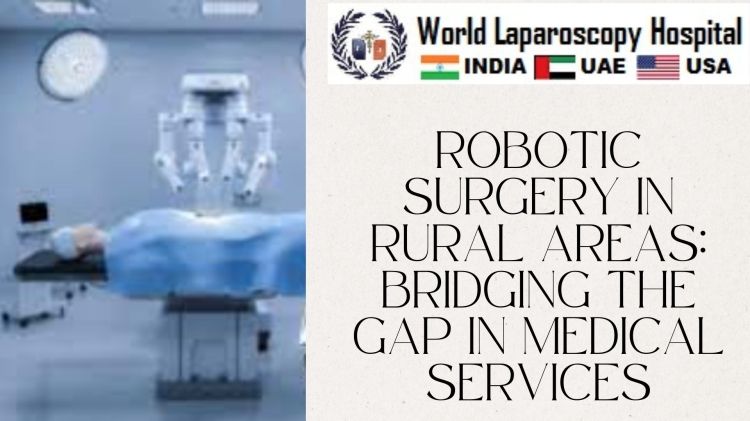Robotic Surgery in Rural Areas: Bridging the Gap in Medical Services
Robotic Surgery in Rural Areas: Bridging the Gap in Medical Services
Introduction:
In recent years, the field of medicine has witnessed a transformative shift with the advent of robotic surgery. This technological advancement has not only revolutionized procedures in urban medical centers but is also proving to be a game-changer in rural healthcare settings. As rural areas often face challenges in providing advanced medical services, the integration of robotic surgery has emerged as a beacon of hope, bridging the gap in healthcare accessibility.

The Challenges of Rural Healthcare:
Rural healthcare has long struggled with issues such as limited access to specialized medical professionals, infrastructure constraints, and the need for patients to travel significant distances for advanced treatments. These challenges contribute to delays in diagnosis, compromised patient outcomes, and a strain on the already burdened healthcare system.
The Rise of Robotic Surgery:
Robotic surgery, utilizing advanced robotic systems controlled by skilled surgeons, has gained prominence for its ability to overcome many of the challenges faced in rural healthcare. These systems, equipped with miniature cameras and precision instruments, enable surgeons to perform minimally invasive procedures with enhanced accuracy.
Advantages of Robotic Surgery in Rural Areas:
Precision and Accuracy:
Robotic systems offer unparalleled precision, allowing surgeons to perform intricate procedures with enhanced accuracy. In rural areas where specialized surgeons may be scarce, this technology enables local practitioners to provide high-quality care.
Minimally Invasive Procedures:
Robotic surgery minimizes the need for large incisions, resulting in quicker recovery times and reduced post-operative pain. Patients in rural areas can benefit from shorter hospital stays, making healthcare more accessible and cost-effective.
Remote Collaboration:
One of the significant advantages of robotic surgery is the potential for remote collaboration. Skilled surgeons from urban centers can connect with rural healthcare facilities, guiding local teams through procedures and expanding the reach of specialized medical expertise.
Skill Augmentation:
In rural settings, where the pool of experienced surgeons may be limited, robotic surgery acts as a skill augmentation tool. Less experienced surgeons can leverage the guidance and precision offered by robotic systems, enhancing the overall quality of surgical interventions.
Successful Implementations in Rural Areas:
Several instances around the world showcase the successful integration of robotic surgery in rural healthcare settings. In the United States, for example, robotic surgery has been utilized in small-town hospitals to perform complex procedures, ensuring that patients do not have to travel to metropolitan areas for specialized care.
Similarly, in developing countries, where access to advanced medical services is often a challenge, mobile robotic surgery units have been deployed to remote areas. These units, equipped with state-of-the-art robotic systems, bring specialized surgical expertise directly to underserved communities.
Challenges and Considerations:
While the integration of robotic surgery in rural areas holds tremendous promise, certain challenges and considerations must be addressed.
Cost:
The initial setup costs for robotic surgery systems can be substantial. Rural healthcare facilities may face financial constraints in acquiring and maintaining these technologies. Public-private partnerships and government initiatives can play a crucial role in overcoming this hurdle.
Training and Education:
Ensuring that local healthcare professionals are adequately trained to operate robotic systems is imperative. Training programs and workshops should be implemented to familiarize medical staff in rural areas with the nuances of robotic surgery.
Infrastructure:
Reliable infrastructure, including a stable internet connection, is crucial for the success of remote collaboration in robotic surgery. Rural areas often face challenges in this regard, necessitating investments in infrastructure development.
Ethical and Legal Considerations:
The use of robotic surgery in rural areas raises ethical and legal questions, particularly concerning patient consent, privacy, and the accountability of remote surgeons. A robust regulatory framework must be established to address these concerns and ensure patient safety.
Future Prospects:
As technology continues to evolve, the future of robotic surgery in rural areas looks promising. Advancements in artificial intelligence (AI) and machine learning can enhance the capabilities of robotic systems, making them more intuitive and adaptive to individual patient needs. Additionally, the development of cost-effective robotic platforms tailored for resource-limited settings can further democratize access to advanced healthcare.
Conclusion:
Robotic surgery is undeniably transforming healthcare in rural areas, acting as a catalyst in bridging the gap in medical services. The integration of this technology empowers local healthcare professionals, improves patient outcomes, and reduces the disparities in access to specialized care. While challenges persist, collaborative efforts from the healthcare industry, government bodies, and technological innovators can pave the way for a future where advanced medical services are accessible to all, regardless of geographical location. As we continue to explore the potential of robotic surgery, the prospect of a more equitable and inclusive healthcare landscape in rural areas beckons.
Top
Introduction:
In recent years, the field of medicine has witnessed a transformative shift with the advent of robotic surgery. This technological advancement has not only revolutionized procedures in urban medical centers but is also proving to be a game-changer in rural healthcare settings. As rural areas often face challenges in providing advanced medical services, the integration of robotic surgery has emerged as a beacon of hope, bridging the gap in healthcare accessibility.

The Challenges of Rural Healthcare:
Rural healthcare has long struggled with issues such as limited access to specialized medical professionals, infrastructure constraints, and the need for patients to travel significant distances for advanced treatments. These challenges contribute to delays in diagnosis, compromised patient outcomes, and a strain on the already burdened healthcare system.
The Rise of Robotic Surgery:
Robotic surgery, utilizing advanced robotic systems controlled by skilled surgeons, has gained prominence for its ability to overcome many of the challenges faced in rural healthcare. These systems, equipped with miniature cameras and precision instruments, enable surgeons to perform minimally invasive procedures with enhanced accuracy.
Advantages of Robotic Surgery in Rural Areas:
Precision and Accuracy:
Robotic systems offer unparalleled precision, allowing surgeons to perform intricate procedures with enhanced accuracy. In rural areas where specialized surgeons may be scarce, this technology enables local practitioners to provide high-quality care.
Minimally Invasive Procedures:
Robotic surgery minimizes the need for large incisions, resulting in quicker recovery times and reduced post-operative pain. Patients in rural areas can benefit from shorter hospital stays, making healthcare more accessible and cost-effective.
Remote Collaboration:
One of the significant advantages of robotic surgery is the potential for remote collaboration. Skilled surgeons from urban centers can connect with rural healthcare facilities, guiding local teams through procedures and expanding the reach of specialized medical expertise.
Skill Augmentation:
In rural settings, where the pool of experienced surgeons may be limited, robotic surgery acts as a skill augmentation tool. Less experienced surgeons can leverage the guidance and precision offered by robotic systems, enhancing the overall quality of surgical interventions.
Successful Implementations in Rural Areas:
Several instances around the world showcase the successful integration of robotic surgery in rural healthcare settings. In the United States, for example, robotic surgery has been utilized in small-town hospitals to perform complex procedures, ensuring that patients do not have to travel to metropolitan areas for specialized care.
Similarly, in developing countries, where access to advanced medical services is often a challenge, mobile robotic surgery units have been deployed to remote areas. These units, equipped with state-of-the-art robotic systems, bring specialized surgical expertise directly to underserved communities.
Challenges and Considerations:
While the integration of robotic surgery in rural areas holds tremendous promise, certain challenges and considerations must be addressed.
Cost:
The initial setup costs for robotic surgery systems can be substantial. Rural healthcare facilities may face financial constraints in acquiring and maintaining these technologies. Public-private partnerships and government initiatives can play a crucial role in overcoming this hurdle.
Training and Education:
Ensuring that local healthcare professionals are adequately trained to operate robotic systems is imperative. Training programs and workshops should be implemented to familiarize medical staff in rural areas with the nuances of robotic surgery.
Infrastructure:
Reliable infrastructure, including a stable internet connection, is crucial for the success of remote collaboration in robotic surgery. Rural areas often face challenges in this regard, necessitating investments in infrastructure development.
Ethical and Legal Considerations:
The use of robotic surgery in rural areas raises ethical and legal questions, particularly concerning patient consent, privacy, and the accountability of remote surgeons. A robust regulatory framework must be established to address these concerns and ensure patient safety.
Future Prospects:
As technology continues to evolve, the future of robotic surgery in rural areas looks promising. Advancements in artificial intelligence (AI) and machine learning can enhance the capabilities of robotic systems, making them more intuitive and adaptive to individual patient needs. Additionally, the development of cost-effective robotic platforms tailored for resource-limited settings can further democratize access to advanced healthcare.
Conclusion:
Robotic surgery is undeniably transforming healthcare in rural areas, acting as a catalyst in bridging the gap in medical services. The integration of this technology empowers local healthcare professionals, improves patient outcomes, and reduces the disparities in access to specialized care. While challenges persist, collaborative efforts from the healthcare industry, government bodies, and technological innovators can pave the way for a future where advanced medical services are accessible to all, regardless of geographical location. As we continue to explore the potential of robotic surgery, the prospect of a more equitable and inclusive healthcare landscape in rural areas beckons.
